Study of the Oxidation Behavior of Fine-Grained Graphite ET-10 by Combining X-ray μCT with Mercury Porosimetry
Abstract
:1. Introduction
2. Materials and Methods
2.1. Test Specimen
2.2. Oxidation Facility and Experiment Procedure
2.3. Oxidation Rate and Porosity
2.4. X-ray μCT
2.5. Processing and Analyzing Images
- The SiC part and the graphite part of the specimens before oxidation are cylinders, and the differences in their diameters are the same;
- The shape of the SiC part in the specimen is not changed after being oxidized. Its mass loss due to oxidation is determined by the oxidation time;
- The whole specimen can be divided axially into two halves, and they are symmetrical.
2.6. Pore Structure Analysis
2.7. Simulation of Micro-Hydromechanics
3. Results
3.1. Oxidation Rate
3.2. Porosities of Pure Specimens Assessed using a Mercury Porosimeter
3.3. 3D Pictures of SiC-Coated Graphite Specimen Captured by X-ray μCT
3.4. Pore Structure Analysis by Combining X-ray μCT with Mercury Porosimetry
3.4.1. Porosity of Unoxidized Graphite Component Far Away from the SiC Coating
3.4.2. Porosity of Half of the Partially SiC-Coated Graphite Specimen
3.4.3. Geometry of Pores
3.5. Simulation Results of Micro-Hydromechanics
3.5.1. Gas Velocity Distributions of Pure Graphite Specimens
3.5.2. Gas Velocity Distributions for Partially SiC-Coated Graphite Specimens
4. Discussion
4.1. Oxygen Supply, Grain Size and Geometry of Specimen
4.2. Specialities of Small Partially SiC-Coated Graphite Specimen
- The SiC coating is a high-hardness material and the graphite is a low-hardness material. The uneven side surface and the carbon dust present in it due to the wire cutting (Figure 8) may accelerate the oxidation of the outermost region;
- The angle between the gas flow and the specimen at the bottom section of the U-tube introduces the high-speed tangential component of gas flow close to the specimen (the first column of Figure 16). This also accelerates the oxidation of the outermost region of the specimen.
4.3. Conditions for Oxidation Experiment
- As shown in Figure 16, the gas flow in the specimen is uniform when its two round faces are covered by SiC;
- The short distance from the surface to the inside of the small specimen means the oxygen in the gas can penetrate the specimen’s interior before being exhausted via oxidation;
- The oxidation rate is quick. It only took several minutes to reach around 10% mass loss at 700 °C. We can repeat the oxidation experiments easily;
- The millimeter specimen facilitates the measurements employed for observing the microstructure of the specimen, e.g., X-ray μCT, SEM;
- The costs for constructing and operating the small test facility are lower than those for a large test facility.
4.4. What Was Oxidized and Its Relevance to the Three-Regime Theory
4.5. Future Studies
- To process the high-hardness SiC, wire cutting was adopted. However, the side surface of the obtained SiC-coated specimen was very uneven, and a lot of carbon dust penetrated the uneven side’s surface;
- The arc flow path in the bottom section of the U-tube resulted in the high-speed tangential component of the gas flow close to the specimen.
- A detachable structure using SiC or other non-corrosive materials will be adopted to cover the two round faces of the small pure cylinder graphite. Pure cylinder graphite can be produced easily with low contents of carbon dust in the even side surface;
- The U-tube will have a long straight bottom section and the specimen will be placed in the middle of the center of the bottom section.
- Graphite: ET-10, IG-110, etc.;
- Airflow at inlet: 0.005–0.06 L/min;
- Geometry of the graphite specimen: D = 0.5–1.5 mm, H = 1–2 mm;
- Inner diameter of the quartz tube: 3–5 mm;
- Oxidation temperature range: 500–800 °C;
- Observations of the microstructure and impurities: X-ray μCT, mercury porosimetry, SEM, EDX (energy-dispersive X-ray spectroscopy) [6], etc.
- The related discussion of the oxidation mechanism for synthesizing graphite oxide [46] can provide a clue for establishing the model for chemically kinetics-controlled oxidation. Some related studies had been successfully carried out [13]. In addition, the related oxidation processes and oxidizing agents may help to selectively oxidize the binder or the filler for contrast experiments.
- The oxidation mechanism of the filler grain may be relevant to the related kinetics study of the oxidation of highly oriented pyrolytic graphite (HOPG) [47,48]. The properties of HOPG are similar to those of the graphite grain. The beginning stage of the oxidation with a low gas flow rate (0.3 L/min) at 600 °C [49] (p. 86) is similar to that of the HOPG [47] (p. 9946).
- The oxidation of nuclear graphite will be varied with the evolution of the oxidized compositions and the oxygen supply due to the interactions among the intrinsic characteristics and exterior conditions, e.g., the ratios of the different compositions, geometry, microstructure, gas flow rate, temperature, mass loss, etc. The two above-mentioned mechanisms should be integrated to establish a comprehensive model for the oxidation of nuclear graphite.
5. Conclusions
Author Contributions
Funding
Data Availability Statement
Acknowledgments
Conflicts of Interest
References
- Irvine, J.M. Nuclear Power: A Very Short Introduction; Oxford University Press: Oxford, UK; New York, NY, USA, 2011; ISBN 978-0-19-958497-0. [Google Scholar]
- U.S. DOE Nuclear Energy Research Advisory Committee; Generation IV International Forum. A Technology Roadmap for Generation IV Nuclear Energy Systems; U.S. DOE Nuclear Energy Research Advisory Committee, Generation IV International Forum: Washington, DC, USA, 2002. [Google Scholar]
- Bowden-Reid, R.; Khachan, J. An inertial electrostatic confinement fusion system based on graphite. Phys. Plasmas 2021, 28, 042703. [Google Scholar] [CrossRef]
- Tanabe, T. Revisiting carbon materials as plasma-facing material of a fusion reactor. Plasma Phys. Rep. 2019, 45, 300–314. [Google Scholar] [CrossRef]
- Goriaev, A.; Wauters, T.; Brakel, R.; Brezinsek, S.; Dinklage, A.; Fellinger, J.; Grote, H.; Moseev, D.; Sereda, S.; Volzke, O. Wall conditioning at the Wendelstein 7-X stellarator operating with a graphite divertor. Phys. Scr. 2020, T171, 014063. [Google Scholar] [CrossRef]
- Alanazi, H.; Alharbi, Y.R.; Abadel, A.A.; Elalaoui, O. Effect of edge oxidized graphene oxide on micro and macro mechanical properties and microstructure of cement paste. Int. J. Mater. Res. 2022, 113, 271–277. [Google Scholar] [CrossRef]
- Zhou, X.; Yang, Y.; Song, J.; Lu, Z.; Zhang, J.; Liu, B.; Tang, Y. Carbon materials in a high temperature gas-cooled reactor pebble-bed module. New Carbon Mater. 2018, 33, 97–108. [Google Scholar] [CrossRef]
- Yu, X.; Yu, S. The gasification of graphite matrix in pebble bed reactors. In Proceedings of the Volume 2: Structural Integrity, Safety and Security, Advanced Applications of Nuclear Technology, Balance of Plant for Nuclear Applications, Brussels, Belgium, 12–16 July 2009; ASMEDC: Brussels, Belgium, 2009; pp. 685–690. [Google Scholar]
- Sun, X.; Dong, Y.; Zhou, Y.; Li, Z.; Shi, L.; Sun, Y.; Zhang, Z. Effects of reaction temperature and inlet oxidizing gas flow rate on IG-110 graphite oxidation used in HTR-PM. J. Nucl. Sci. Technol. 2017, 54, 196–204. [Google Scholar] [CrossRef]
- Moormann, R.; Hinssen, H.-K.; Kühn, K. Oxidation behaviour of an HTR fuel element matrix graphite in oxygen compared to a standard nuclear graphite. Nucl. Eng. Des. 2004, 227, 281–284. [Google Scholar] [CrossRef]
- Chen, Z.; Chen, X.; Zheng, Y.; Sun, J.; Chen, F.; Shi, L.; Li, F.; Dong, Y.; Zhang, Z. Air ingress analysis of chimney effect in the 200 MWe pebble-bed modular high temperature gas-cooled reactor. Ann. Nucl. Energy 2017, 106, 143–153. [Google Scholar] [CrossRef]
- Yadav, S.K.; Joshi, M.; Sharma, Y.; Shukla, P.; Kaushik, A.; Sapra, B.K.; Singh, R.S. Physico-chemical characteristics of graphite aerosols generated during postulated air ingress accident. Ann. Nucl. Energy 2019, 132, 100–107. [Google Scholar] [CrossRef]
- El-Genk, M.S.; Tournier, J.M.P. Development and validation of a model for the chemical kinetics of graphite oxidation. J. Nucl. Mater. 2011, 411, 193–207. [Google Scholar] [CrossRef]
- ASTM D7542-15; Standard Test Method for Air Oxidation of Carbon and Graphite in The Kinetic Regime. ASTM: West Conshohocken, PA, USA, 2015.
- Contescu, C.I. Inter-laboratory study to establish precision statements for astm d7542-09, standard test method for air oxidation of manufactured carbon and graphite in kinetic regime. Tech. Rep. 2009, 2959–19428. [Google Scholar]
- Walker, P.L.; Rusinko, F.; Austin, L.G. Gas reactions of carbon. In Advances in Catalysis; Elsevier: Amsterdam, The Netherlands, 1959; Volume 11, pp. 133–221. [Google Scholar]
- Kane, J.J.; Contescu, C.I.; Smith, R.E.; Strydom, G.; Windes, W.E. Understanding the reaction of nuclear graphite with molecular oxygen: Kinetics, transport, and structural evolution. J. Nucl. Mater. 2017, 493, 343–367. [Google Scholar] [CrossRef]
- Contescu, C.I.; Azad, S.; Miller, D.; Lance, M.J.; Baker, F.S.; Burchell, T.D. Practical aspects for characterizing air oxidation of graphite. J. Nucl. Mater. 2008, 381, 15–24. [Google Scholar] [CrossRef]
- Kim, E.S.; NO, H.C. Experimental study on the oxidation of nuclear graphite and development of an oxidation model. J. Nucl. Mater. 2006, 349, 182–194. [Google Scholar] [CrossRef]
- Lee, J.J.; Ghosh, T.K.; Loyalka, S.K. Oxidation rate of nuclear-grade graphite IG-110 in the kinetic regime for vhtr air ingress accident scenarios. J. Nucl. Mater. 2014, 446, 38–48. [Google Scholar] [CrossRef]
- Contescu, C.I.; Guldan, T.; Wang, P.; Burchell, T.D. The effect of microstructure on air oxidation resistance of nuclear graphite. Carbon 2012, 50, 3354–3366. [Google Scholar] [CrossRef]
- Wang, P.; Yu, S.Y. Effects of gas flow rate and temperature on the oxidation rate of ig-110 nuclear graphite. J. Tsinghua Univ. Sci. Tech. 2012, 52, 504–507. [Google Scholar]
- Wang, P. The Oxidation Performance of IG-110 Nuclear Graphite Used in HTGRs. Ph.D. Thesis, Tsinghua University, Beijing, China, 2013. [Google Scholar]
- Chi, S.H. Effects of specimen size on the flexural strength and Weibull modulus of nuclear graphite IG-110, NGB-18, and PCEA. J. Nucl. Mater. 2014, 446, 38–48. [Google Scholar]
- Zhao, Y.; Dong, Y.; Zhou, Y.; Li, Z.; Zhang, Z. Oxidation experiments and kinetics analysis of nuclear graphite ET-10 by gas analysis and microstructure observation. Energies 2021, 14, 6392. [Google Scholar] [CrossRef]
- Smith, R.E.; Kane, J.J.; Windes, W.E. Determining the acute oxidation behavior of several nuclear graphite grades. J. Nucl. Mater. 2021, 545, 152648. [Google Scholar] [CrossRef]
- Chi, S.H.; Kim, G.C. Effects of air flow rate on the oxidation of NBG-18 and NBG-25 nuclear graphite. J. Nucl. Mater. 2017, 491, 37–42. [Google Scholar] [CrossRef]
- Yan, R.; Dong, Y.; Zhou, Y.; Sun, X.; Li, Z. Investigation of oxidation behaviors of nuclear graphite being developed and IG-110 based on gas analysis. J. Nucl. Sci. Technol. 2017, 54, 1168–1177. [Google Scholar] [CrossRef]
- Zhou, Y.; Dong, Y.; Yin, H.; Li, Z.; Yan, R.; Li, D.; Gu, Z.; Sun, X.; Shi, L.; Zhang, Z. Characterizing thermal-oxidation behaviors of nuclear graphite by combining O2 supply and micro surface area of graphite. Sci. Rep. 2018, 8, 13400. [Google Scholar] [CrossRef] [PubMed]
- Chi, S.H.; Kim, G.C. Comparison of the oxidation rate and degree of graphitization of selected IG and NBG nuclear graphite grades. J. Nucl. Mater. 2008, 381, 9–14. [Google Scholar] [CrossRef]
- Lo, I.H.; Yeh, T.K.; Patterson, E.A.; Tzelep, A. Comparison of oxidation behavior of nuclear graphite grades at very high temperatures. J. Nucl. Mater. 2020, 532, 152054. [Google Scholar] [CrossRef]
- O’Sullivan, J.D.B.; Behnsen, J.; Starborg, T.; MacDonald, A.S.; Phythian-Adams, A.T.; Else, K.J.; Cruickshank, S.M.; Withers, P.J. X-ray micro-computed tomography (μCT): An emerging opportunity in parasite imaging. Parasitology 2018, 145, 848–854. [Google Scholar] [CrossRef] [Green Version]
- Sumita, J.; Shibata, T.; Fujita, I.; Kunimoto, E.; Yamaji, M.; Eto, M.; Konishi, T.; Sawa, K. Development of evaluation method with X-Ray tomography for material property of IG-430 graphite for VHTR/HTGR. Nucl. Eng. Des. 2014, 271, 314–317. [Google Scholar] [CrossRef]
- Liu, Q.; Xu, D.; Tan, C. Evolution of pore structure and fractal characteristics of graphite lining in rare earth electrolytic cell during high temperature oxidation. Chem. Ind. Eng. Prog. 2019, 38, 1468–1475. [Google Scholar]
- Cho, Y.J.; Garcia, D.; Yu, H.Z.; Deng, Z.; Li, L.; Lu, K. Oxidation behaviors of matrix-grade graphite during water vapor ingress accidents for high temperature gas-cooled reactors. Carbon 2021, 185, 161–176. [Google Scholar] [CrossRef]
- Lu, W.; Li, X.; Wu, X.; Sun, L.; Li, Z. Investigation on the oxidation behavior and multi-step reaction mechanism of nuclear graphite SNG742. J. Nucl. Sci. Technol. 2020, 57, 263–275. [Google Scholar] [CrossRef]
- Hannon, L.; Lie, G.C.; Clementi, E. Micro-hydrodynamics. J. Stat. Phys. 1988, 51, 965–979. [Google Scholar] [CrossRef]
- Wolf, F.G.; Santos, L.O.E.; Philippi, P.C. Micro-hydrodynamics of immiscible displacement inside two-dimensional porous media. Microfluid Nanofluidics 2008, 4, 307–319. [Google Scholar] [CrossRef]
- Hu, Z.; Zheng, D.; Tu, R.; Yang, M.; Li, Q.; Han, M.; Zhang, S.; Zhang, L.; Goto, T. Structural control of highly-oriented polycrystal 3C-SiC bulks via halide CVD. Materials 2019, 12, 390. [Google Scholar] [CrossRef] [PubMed] [Green Version]
- Zhu, Q.; Qiu, X.; Ma, C. Oxidation resistant SiC coating for graphite materials. Carbon 1999, 37, 1475–1484. [Google Scholar] [CrossRef]
- Tang, C.; Gong, J. Improvement in oxidation resistance of the nuclear graphite by reaction-coated SiC coating. J. Nucl. Mater. 1995, 224, 103–108. [Google Scholar]
- He, Z.; Lian, P.; Song, Y.; Liu, Z.; Song, J.; Zhang, J.; Ren, X.; Feng, J.; Yan, X.; Guo, Q.; et al. Protecting nuclear graphite from liquid fluoride salt and oxidation by SiC coating derived from polycarbosilane. J. Eur. Ceram. Soc. 2018, 38, 453–462. [Google Scholar] [CrossRef]
- Yang, H.; Zhao, H.; Wang, T.; Liu, X.; Zhang, K.; Li, Z.; Gao, Y.; Liu, B. A multi-layered SiC coating to protect graphite spheres from high temperature oxidation in static air. Corros. Sci. 2021, 183, 109325. [Google Scholar] [CrossRef]
- Kim, E.S.; No, H.C.; Kim, B.J.; Oh, C.H. Estimation of graphite density and mechanical strength variation of VHTR during air-ingress accident. Nucl. Eng. Des. 2008, 238, 837–847. [Google Scholar] [CrossRef]
- Huang, W.H.; Tsai, S.C.; Yang, C.W.; Kai, J.J. The relationship between microstructure and oxidation effects of selected IG- and NBG-grade nuclear graphites. J. Nucl. Mater. 2014, 454, 149–158. [Google Scholar] [CrossRef]
- Li, C.; Chen, X.; Shen, L.; Bao, N. Revisiting the oxidation of graphite: Reaction mechanism, chemical stability, and structure self-regulation. ACS Omega 2020, 5, 3397–3404. [Google Scholar] [CrossRef]
- Hahn, J.R.; Kang, H. Mechanistic study of defect-induced oxidation of graphite. J. Phys. Chem. B 1999, 103, 9944–9951. [Google Scholar] [CrossRef] [Green Version]
- Hahn, J.R. Kinetic study of graphite oxidation along two lattice directions. Carbon 2005, 43, 1506–1511. [Google Scholar] [CrossRef]
- Choi, W.K.; Kim, B.J.; Kim, E.S.; Chi, S.H.; Park, S.J. Oxidation behavior of IG and NBG nuclear graphites. Nucl. Eng. Des. 2011, 241, 82–87. [Google Scholar] [CrossRef]

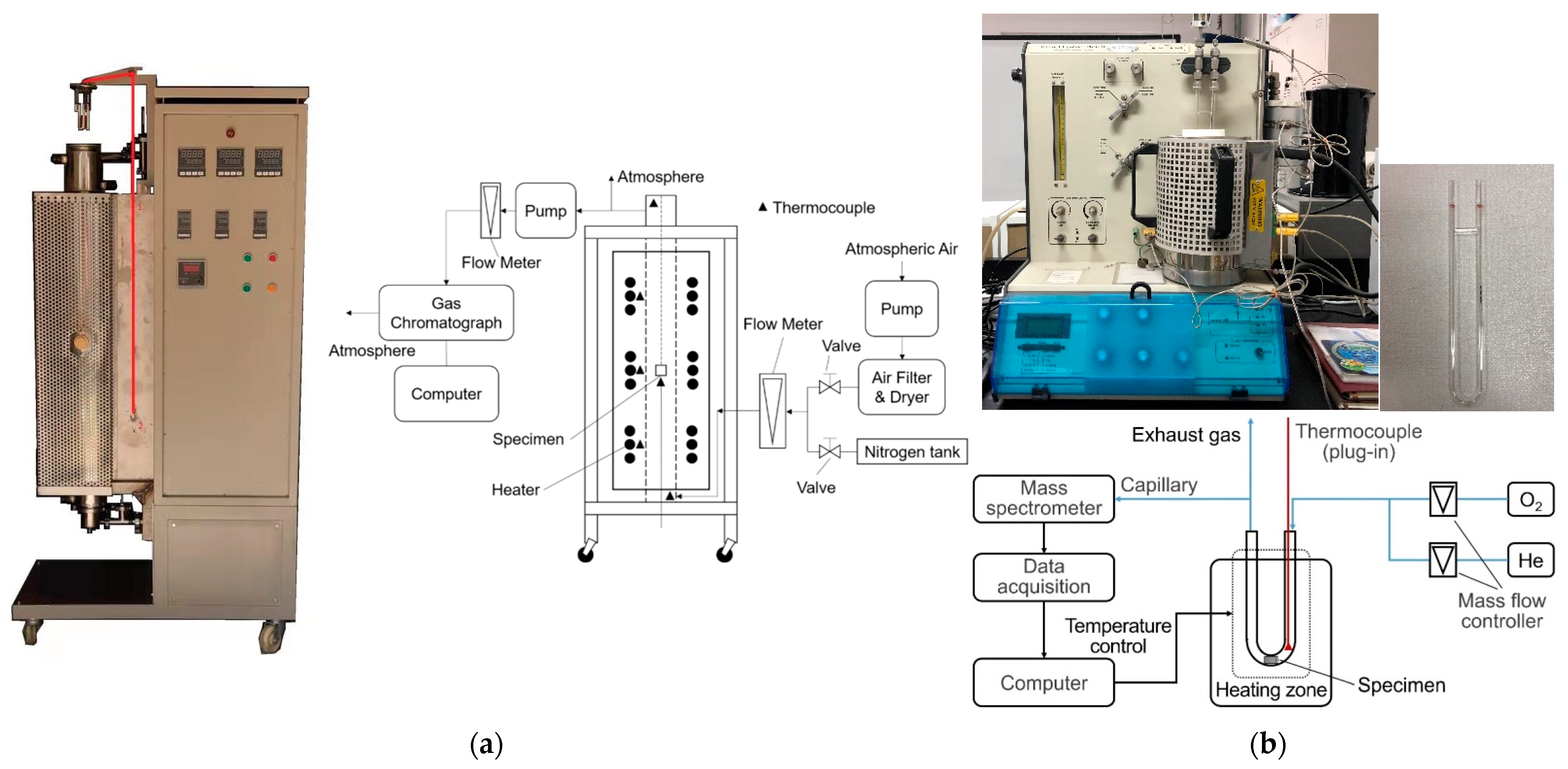
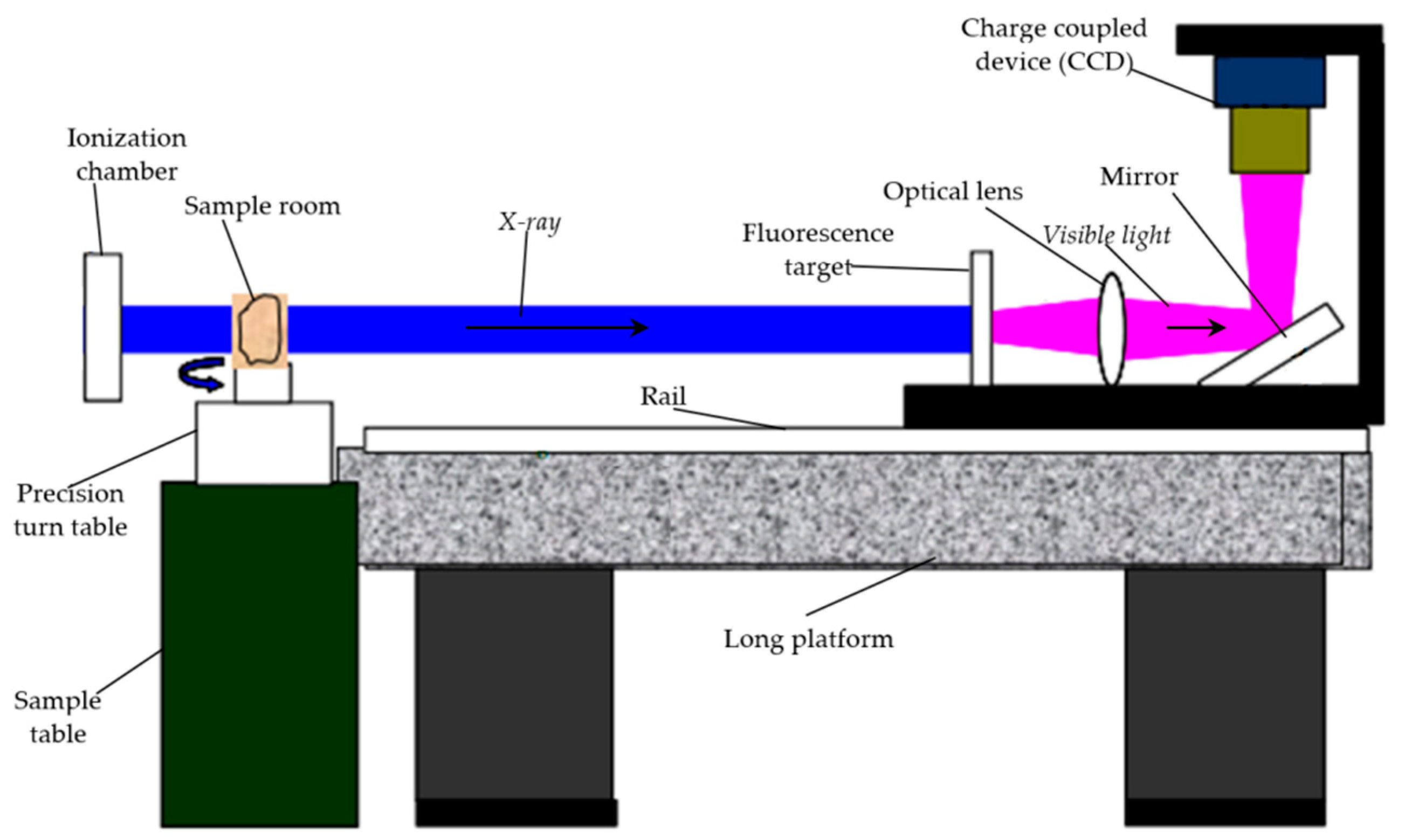

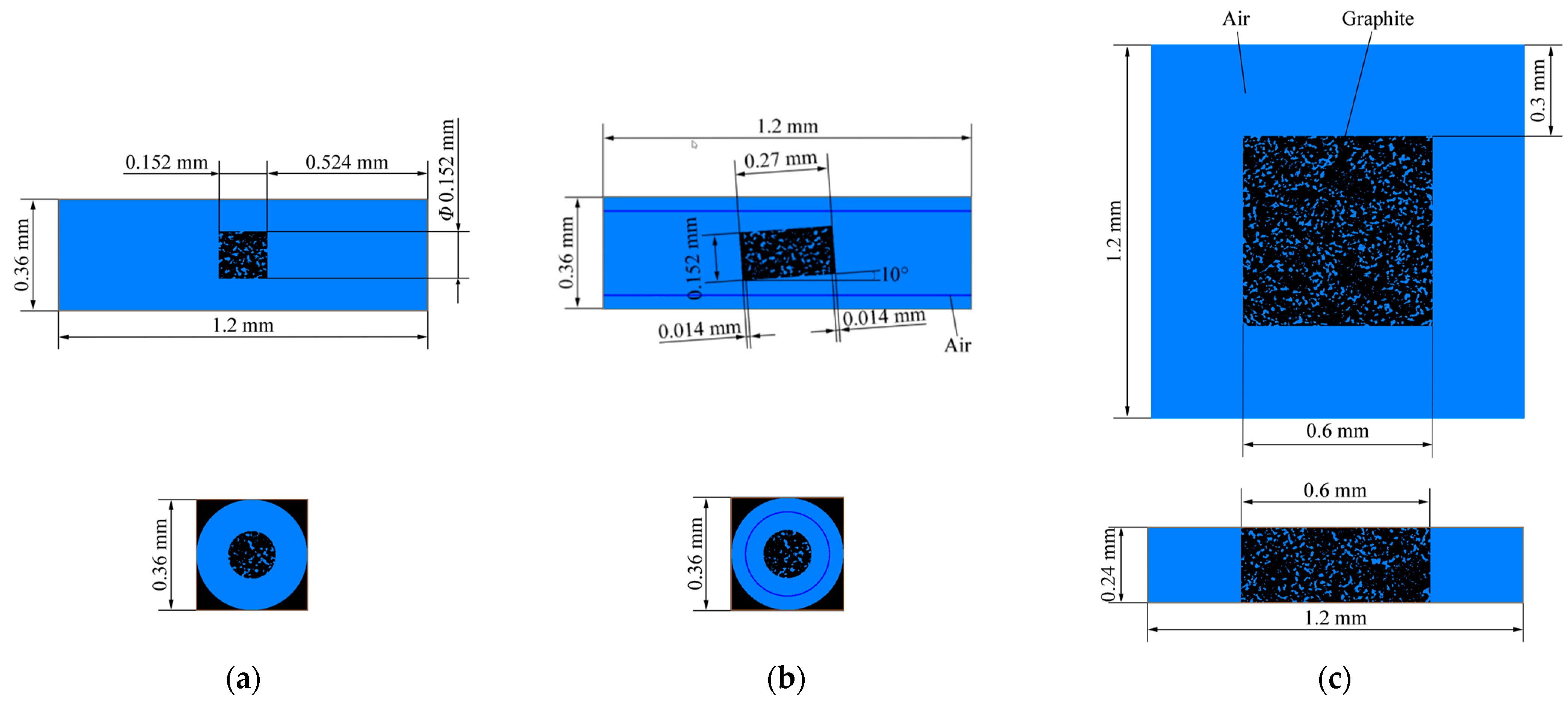
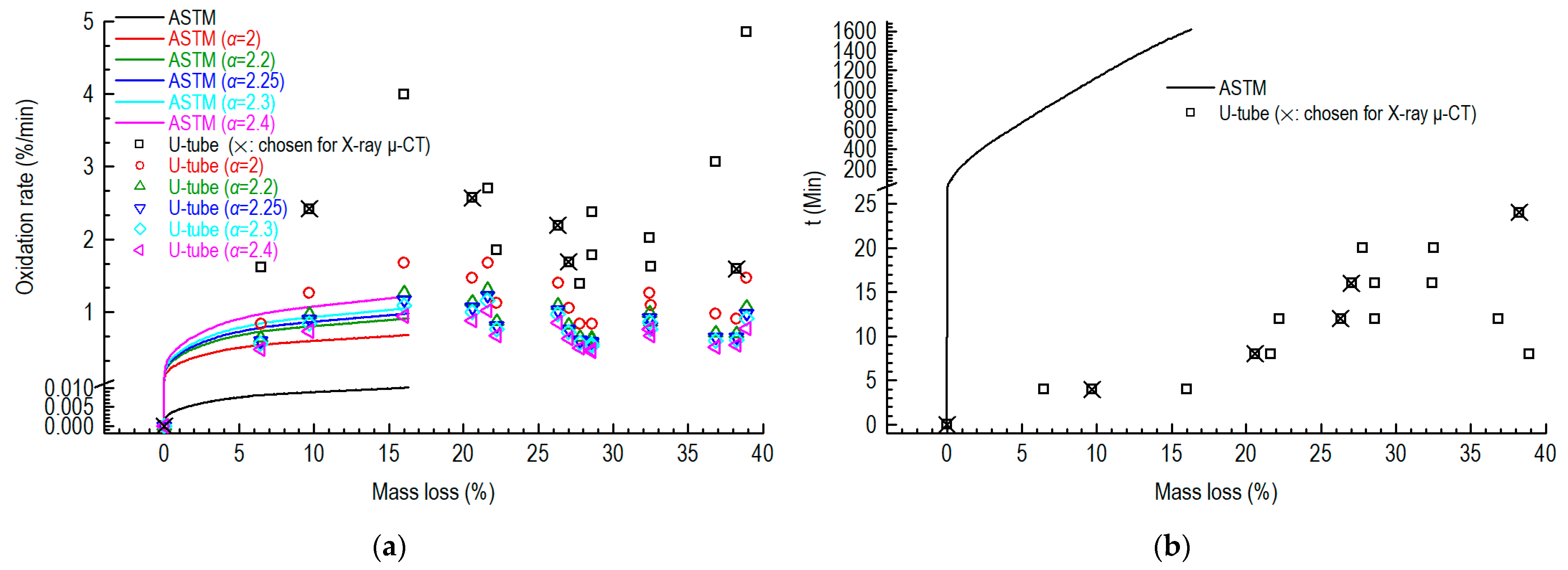


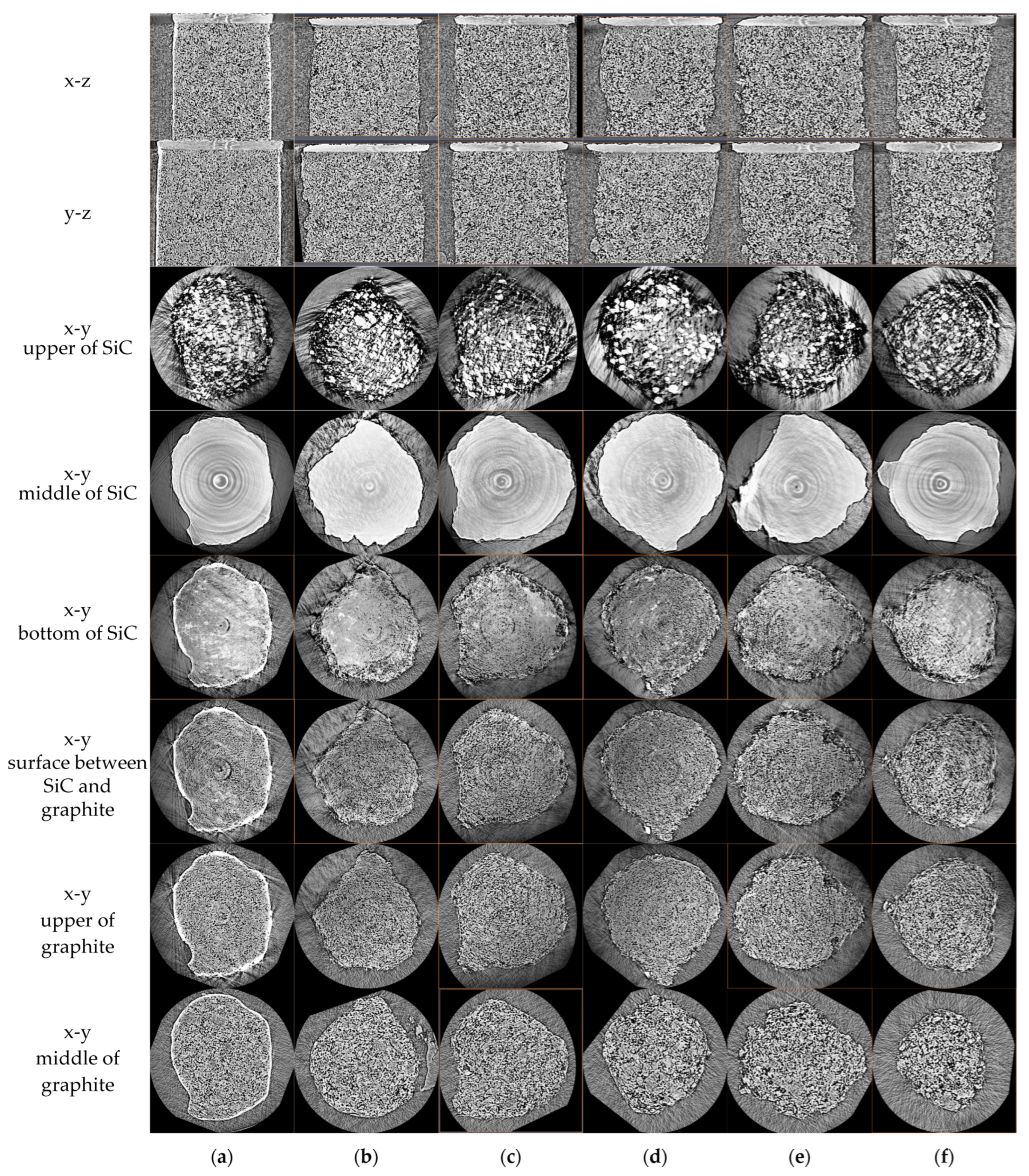
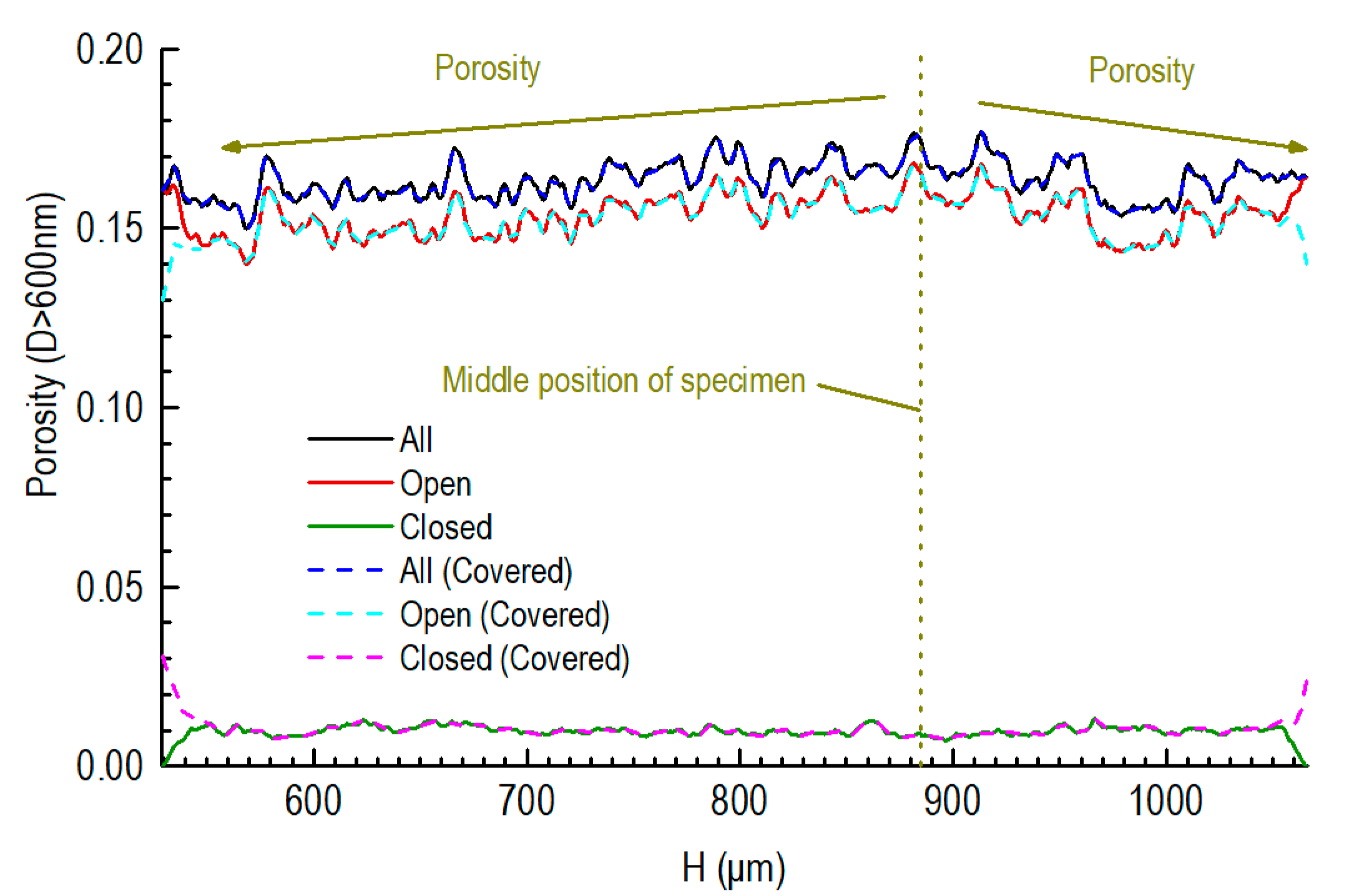
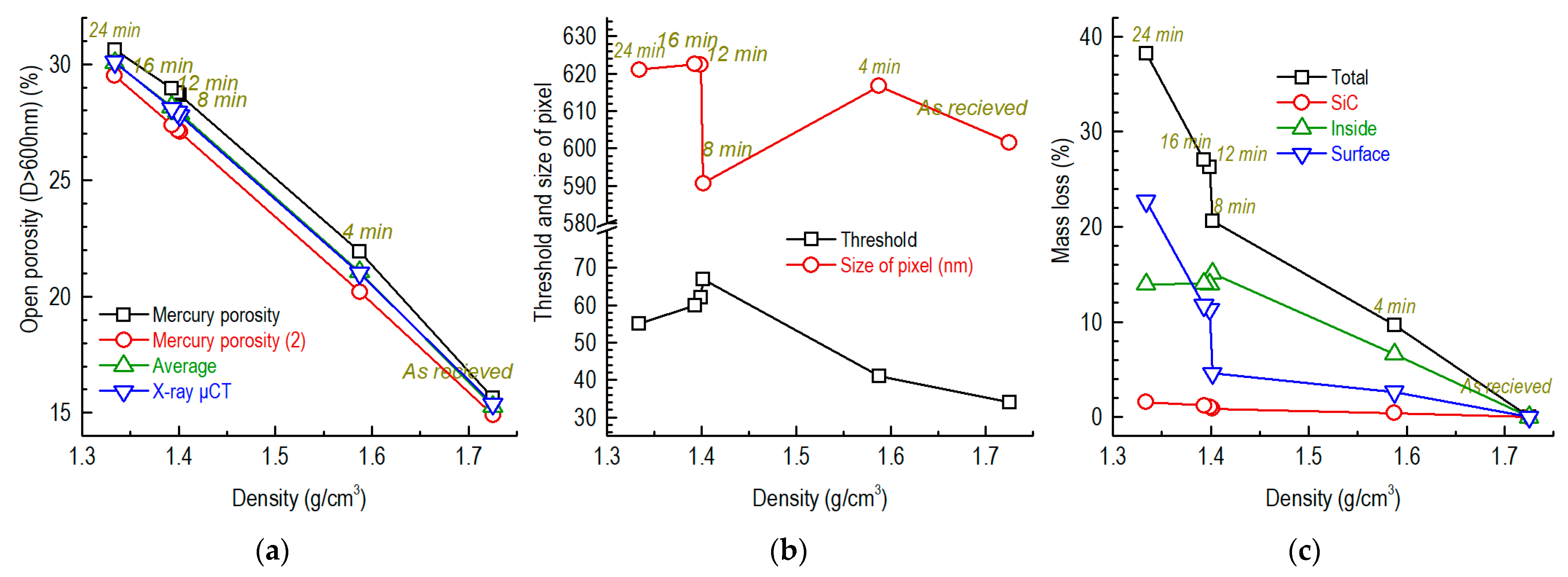

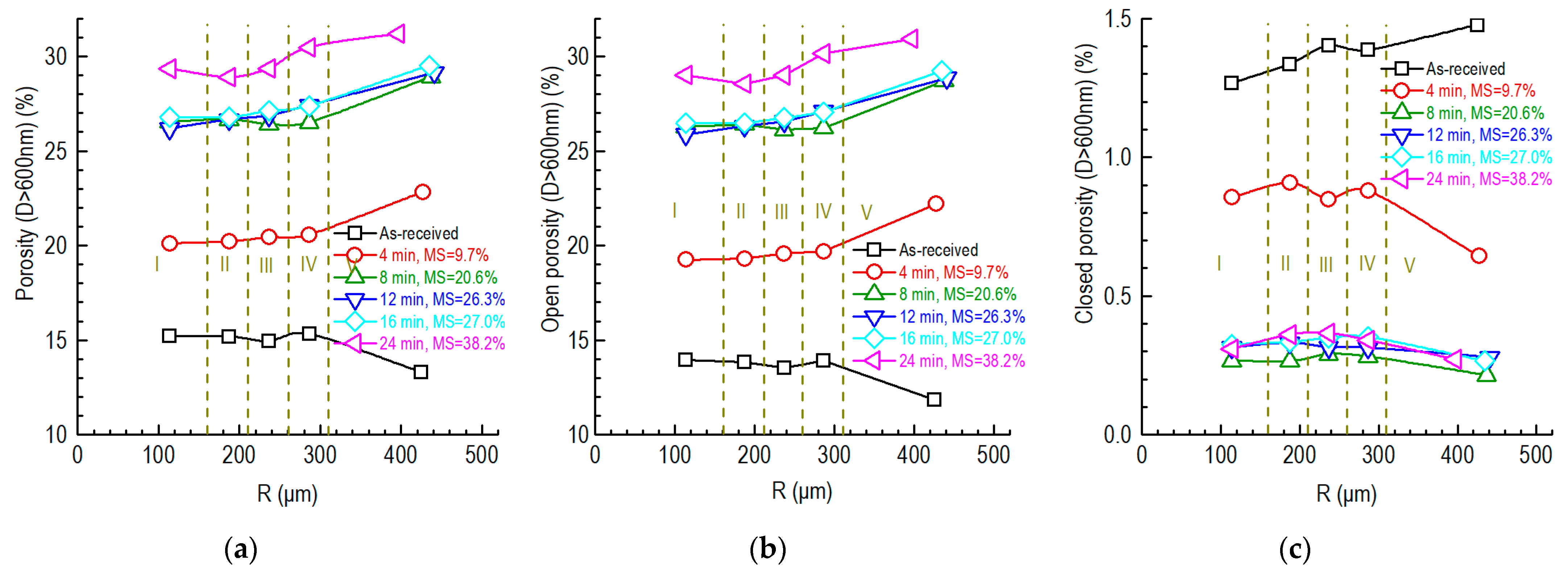
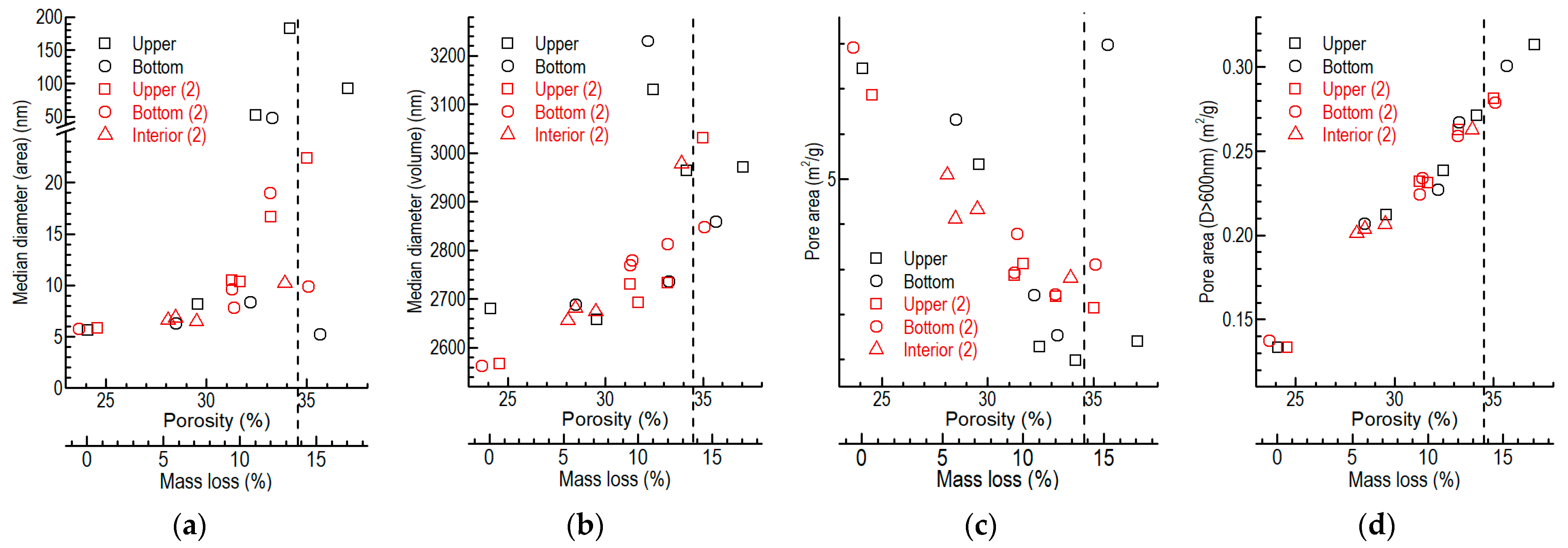
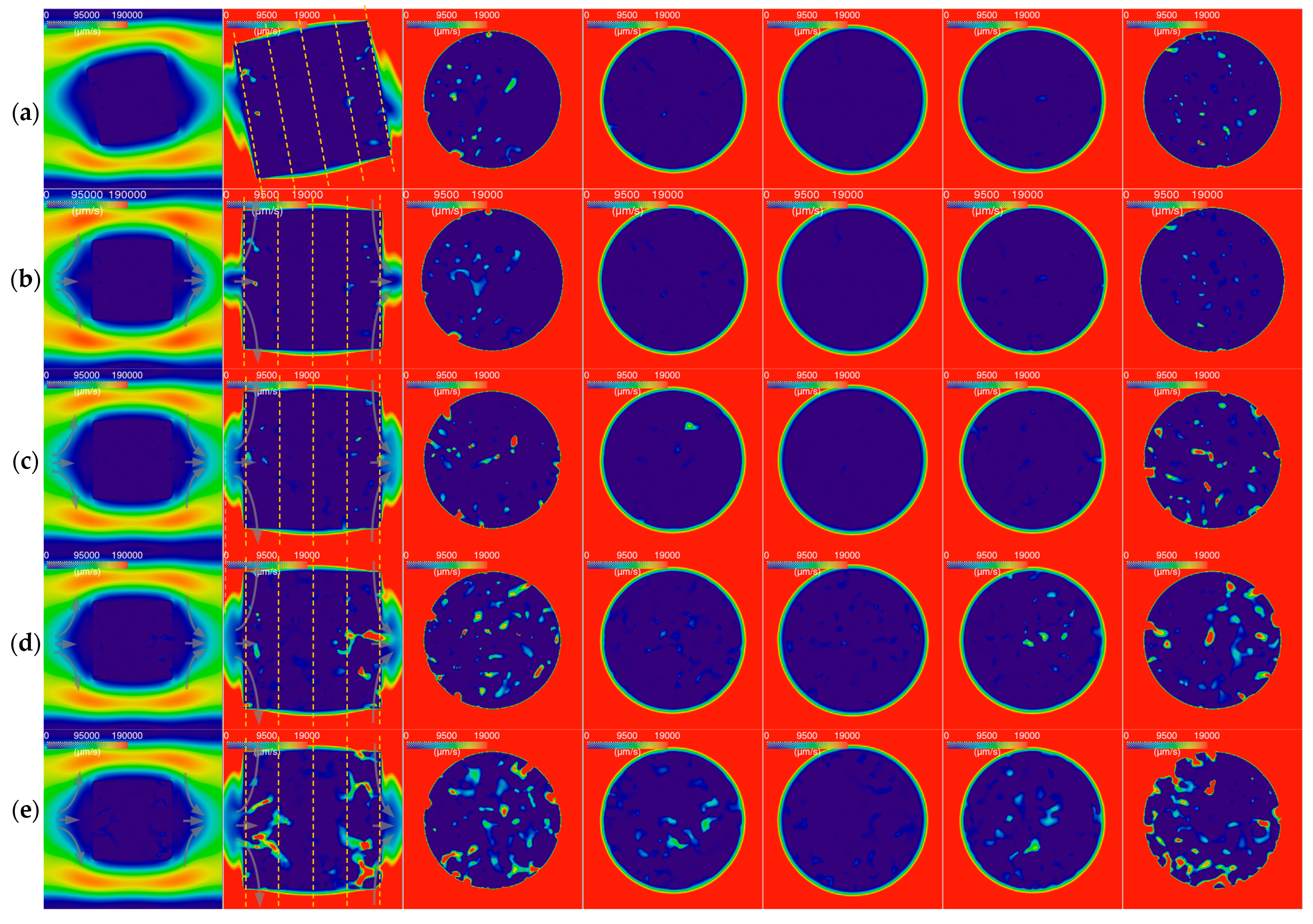
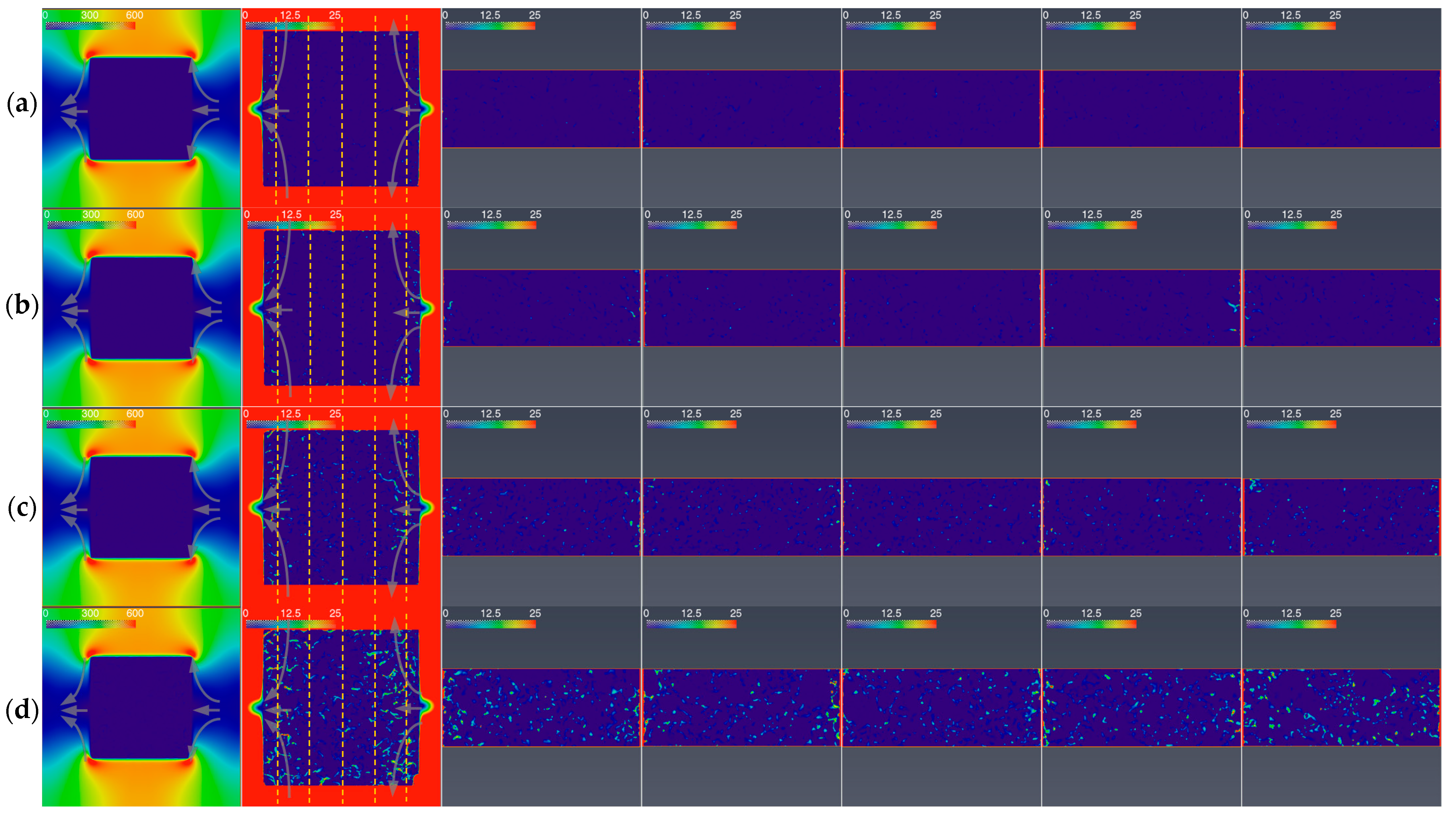
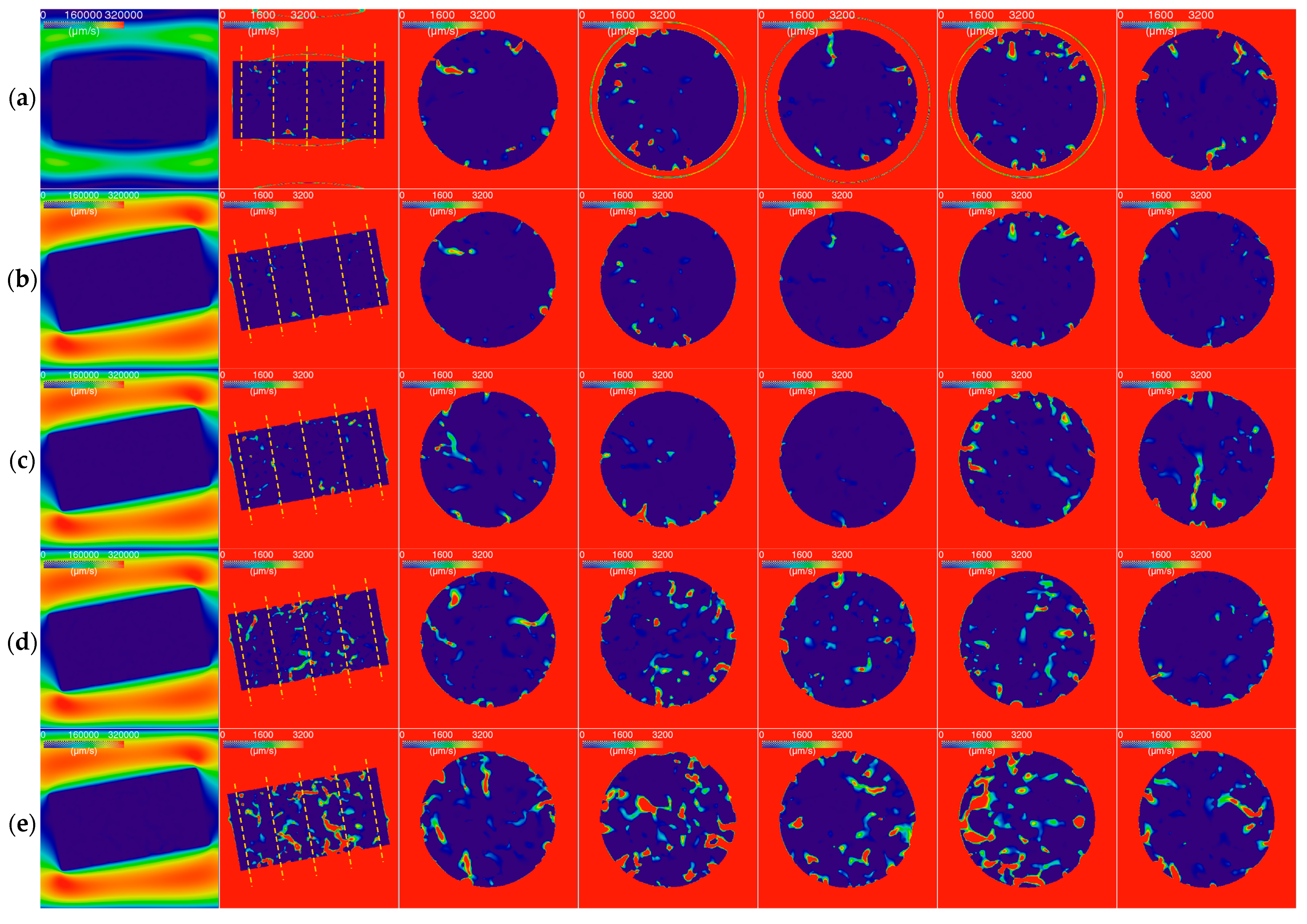
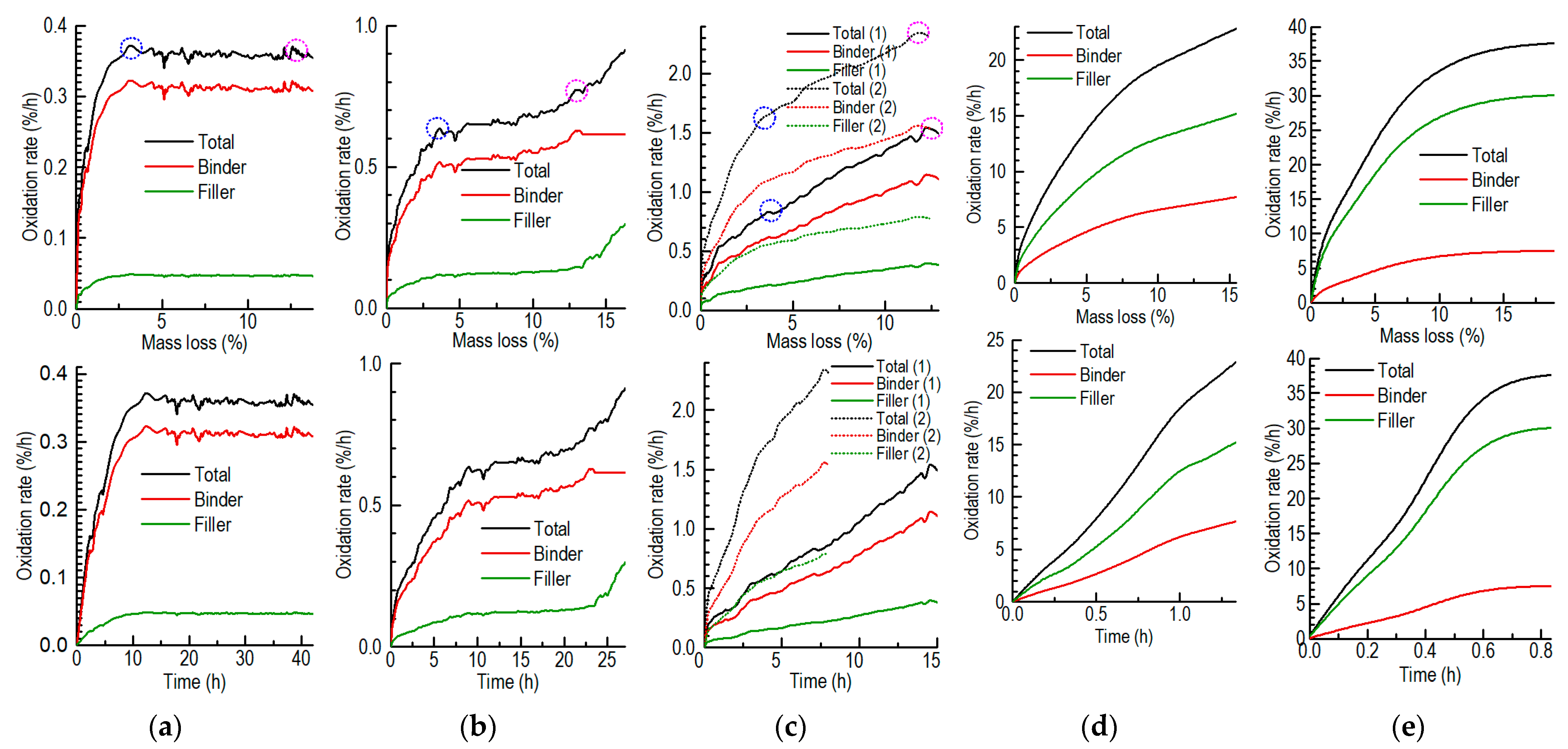
| Impurity | B | Si | Ca | Fe | Al | K | V | Mg |
|---|---|---|---|---|---|---|---|---|
| Value (ppm) | <0.1 | <1.0 | – | <1.2 | <0.1 | – | – | <0.1 |
| No | Geometry (mm) | Temperature (°C) | Time (min) | Flow Rate (L/min) | Oxygen Concentration (%) | Inner Diameter of Tube (mm) | Thickness of SiC (μm) | Density (mg/mm3) | |
|---|---|---|---|---|---|---|---|---|---|
| Graphite | SiC | ||||||||
| 1 | D = H = 25.4 | 675–900 | 480–2520 | 10 | 21% (air) | 65 | \ | 1.725 | \ |
| 2 | D ≈ 1, H = 1.95 | 700 | 4–24 | 0.04 | 10% (He and O2) | 4 | 90 | 1.725 | 2.9 |
| Item Name | CCD Camera | Number of Images | Distance of Two Images (nm) | ||
|---|---|---|---|---|---|
| Size of Pixel (nm2) | Pixel | Magnification | |||
| Value | 740 × 740 | 2048 × 2048 | 10 | 2048 | 600 |
| Item Name | Absolute Permeability Experiment Simulation | Absolute Permeability Tensor Calculation | |||
|---|---|---|---|---|---|
| Pressure at Outlet (Pa) | Flow Rate at Inlet (μm3/s) | Fluid Viscosity (Pa·s) | Convergence Criterion | Iterations | |
| Value | 105 | 1.9 × 1010 | 4.18 × 10−5 | 1 × 10−4 | 5000 |
Publisher’s Note: MDPI stays neutral with regard to jurisdictional claims in published maps and institutional affiliations. |
© 2022 by the authors. Licensee MDPI, Basel, Switzerland. This article is an open access article distributed under the terms and conditions of the Creative Commons Attribution (CC BY) license (https://creativecommons.org/licenses/by/4.0/).
Share and Cite
Zhao, Y.; Dong, Y.; Zhou, Y.; Li, Z.; Yan, R.; Zhang, Z. Study of the Oxidation Behavior of Fine-Grained Graphite ET-10 by Combining X-ray μCT with Mercury Porosimetry. Nanomaterials 2022, 12, 4354. https://doi.org/10.3390/nano12244354
Zhao Y, Dong Y, Zhou Y, Li Z, Yan R, Zhang Z. Study of the Oxidation Behavior of Fine-Grained Graphite ET-10 by Combining X-ray μCT with Mercury Porosimetry. Nanomaterials. 2022; 12(24):4354. https://doi.org/10.3390/nano12244354
Chicago/Turabian StyleZhao, Yumeng, Yujie Dong, Yangping Zhou, Zhengcao Li, Rui Yan, and Zuoyi Zhang. 2022. "Study of the Oxidation Behavior of Fine-Grained Graphite ET-10 by Combining X-ray μCT with Mercury Porosimetry" Nanomaterials 12, no. 24: 4354. https://doi.org/10.3390/nano12244354
APA StyleZhao, Y., Dong, Y., Zhou, Y., Li, Z., Yan, R., & Zhang, Z. (2022). Study of the Oxidation Behavior of Fine-Grained Graphite ET-10 by Combining X-ray μCT with Mercury Porosimetry. Nanomaterials, 12(24), 4354. https://doi.org/10.3390/nano12244354







